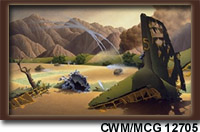 Frances Swyripa's Storied Landscapes: Ethno-Religious Identity and the Canadian Prairies (Winnipeg: University of Manitoba, 2010), examines memory, meaning, and identity in a broad range of European immigrant groups. A series of connections frames the work, which link immigrant groups to other Canadian westerners, Canada as a whole, the mother country and the diaspora. At times these various "imagined communities" could be "overlapping....incompatible and competing." (8) For Swyripa, Ethno-religious identity is a major theme in Canadian regionalism which varies with each group's experience. In tracing the history of heritage, Swyripa notes, "the landscapes are both physical places and places of the mind, the stories the multilayered, sometimes contested narratives and material legacies that immigrant settler peoples mobilized in shaping and claiming those places. "
Frances Swyripa's Storied Landscapes: Ethno-Religious Identity and the Canadian Prairies (Winnipeg: University of Manitoba, 2010), examines memory, meaning, and identity in a broad range of European immigrant groups. A series of connections frames the work, which link immigrant groups to other Canadian westerners, Canada as a whole, the mother country and the diaspora. At times these various "imagined communities" could be "overlapping....incompatible and competing." (8) For Swyripa, Ethno-religious identity is a major theme in Canadian regionalism which varies with each group's experience. In tracing the history of heritage, Swyripa notes, "the landscapes are both physical places and places of the mind, the stories the multilayered, sometimes contested narratives and material legacies that immigrant settler peoples mobilized in shaping and claiming those places. " The attachment to the land and the manner in which it was ordered to gain meaning is an important theme in Storied Landscapes. Immigrant groups that arrived en masse are shown to often invoke the location of arrival as an important place. An interesting aspect of this relationship to the land is described in Ukrainian "cultural conditioning", which could affect selection of homesteads. Life on the steppe had taught that where there were trees there was fertile soil and firewood, yet in the prairie context this land demanded great labour to clear. Many homesteads were chosen in the infertile Interlake region of Manitoba. (43)
Sacred and secular symbols could be appropriated to bond ethnic groups. Numerous types of places served as artifacts which bound ethno-religious groups in a common identity. Communal pilgrimages to shrines could bolster faith, "but also reaffirmed the ethnic community in its primal connection to a specific place and its history." (66) Cemeteries also "helped create psychological and physical bonds to the new country". Founding fathers and arrival places were often a powerful secular symbol for those groups whose history featured a mass immigration.
 |
| Swyripa Lecturing at UofA. CIUS. |
Swyripa also examines the relationship between immigrant groups and other Canadian westerners. At times this is portrayed as a minority hoping to shape its own way of life within a society dominated by the majority. In other cases, the immigrant pioneer is integrated into the greater national narrative of western settlement. On the regional level, the prevalent use of the symbol of wheat and the grain elevator, (on tombstones, municipal logos, and public sculptures), linked the group to the specific lived experience of the prairie and "erased ethno-religious boundaries." (183) Wheat's history as a Christian symbol of "fruitfulness, the staff of life, or...the body of Christ", helped cross the divide between sacred and secular identity. Swyripa also notes conversely, the greater group can at times appropriate the symbols and myths of ethno-religious identity. Originally exclusive and Anglo-Canadian, by the 1930s, "the “old West” relished its diversity, proudly proclaiming cultural pluralism one of the defining features of the regional society." (22)
 |
| CPR Poster in Ukrainian, 1910-1930, GA. |
Swyripa treads wide expanses opening questions for others to explore. Canada's long-running discourse on peasants is one such theme. Swyripa notes that Clifford Sifton's late nineteenth-century immigration policy recruited the eastern-European workers of the soil. How was this notion related to earlier considerations of the Indian Department's Hayter Reed and the peasant farming model which brought severalty to the reserves in the late 1880s? How did later stories about European peasants in memory interact within the larger group's conception of the yeoman pioneer? The relationship between these prairie newcomers and the greater western region are addressed in brief, but a more in-depth consideration of how the experience of these newcomers interacted within western alienation, the rise of Social Credit and the C.C.F., and broader historical changes awaits another book. As a work in the booming field of historical memory which examines the similarities and differences of identity-creation across a range of ethno-religious groups, Swyripa's work is to be recommended.



















